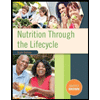
Concept explainers
To determine: The effects of preterm birth of Person E on her nutrition and feeding.
Introduction: Preterm birth is defined as birth of infants before 37 weeks of pregnancy. The preterm birth can be subcategorized based on gestational age such as extremely preterm (> than 28 weeks), very preterm birth (28-32 weeks), moderate-late (32-37 weeks). Preterm birth occurs due to multiple pregnancies, chronic conditions, and infections.
Explanation of Solution
Person E is a former 27-week female infant, weighed 1.14 kg, birth length 38 cm, and other body measurement were appropriate for age. Her mother was 32-year-old women with pre-pregnant BMI of 18 and hypercholesterolemia. Person E’s mother has a 20-month-old daughter and this was her second pregnancy.
Because of Person E’s preterm birth, medical assistance was given to her including respiratory support, parenteral feeds on the day of delivery. It was followed by breast milk supply through orogastric tube which was discontinued due to suspected intolerance. She received blood transfusions due to the anemia of prematurity. Her mom continued to provide breast milk and her weight and length increased progressively. Her feed concentration was increased up to 26 kcal per oz. Due to the suspected gastroesophageal reflex, the feed volume was decreased and feeding concentration was increased up to 28 kcal per oz. Around 37th week, she was bottle feeding and breast feeding well and milk supply was continued. For her development for corrected age, she was enrolled in Early Intervention Program. At six months of corrected age, complementary foods were introduced and at nine months of corrected age she transitioned off to exclusive feeds of breast milk and breast feeding. At 15 months of age, her corrected age was 12 months with all her growth measurements above 50th percentile for corrected age.
Nutrition and infant feeding plays a key role in growth, neurodevelopment, conditioning, and survival of neonates for long-term health. The effects of preterm birth of Person E on her nutrition and feeding are as follows:
- • Breast milk of mother or donor is needed to be fortified to meet the nutritional need of very and extremely preterm baby.
- • Certain gastrointestinal conditions of neonates such as decreased gut motility, gastrointestinal reflux, and impaired absorption interferes with feeding preterm infants.
- • The coordination of suck-swallow-breathe pattern in preterm infants does not occur until 32-34 weeks of postmenstrual age. So different feeding methods like gavage feeding are selected until they achieve successful bottle or breast feeding.
To determine: The effects of preterm birth of Person E on her growth.
Introduction: Preterm birth is defined as birth of infants before 37 weeks of pregnancy. The preterm birth can be subcategorized based on gestational age such as extremely preterm (> than 28 weeks), very preterm birth (28-32 weeks), moderate-late (32-37 weeks). Preterm birth occurs due to multiple pregnancies, chronic conditions, and infections.
Explanation of Solution
Person E is a former 27-week female infant, weighed 1.14 kg, birth length 38 cm, and other body measurement were appropriate for age. Her mother was 32-year-old women with pre-pregnant BMI of 18 and hypercholesterolemia. Person E’s mother have a 20-month-old daughter and this was her second pregnancy.
Because of Person E’s preterm birth, medical assistance was given to her including respiratory support, parenteral feeds on the day of delivery. It was followed by breast milk supply through orogastric tube which was discontinued due to suspected intolerance. She received blood transfusions due to the anemia of prematurity. Her mom continued to provide breast milk and her weight and length increased progressively. Around 37th week, she was bottle feeding and breast feeding well and milk supply was continued. For her development for corrected age, she was enrolled in Early Intervention Program. At six months corrected age, complementary foods were introduced and at nine months of corrected age her she transitioned off to exclusive feeds of breast milk and breast feeding. At 15 months age, her corrected age was 12 months with all her growth measurements above 50th percentile for corrected age.
The effects of preterm birth of Person E on her growth are as follows:
- • Preterm birth causes decreased feeding and slower nutritional uptake, which in turn leads to the slower growth rate of preterm infants.
- • The growth would be slower but should be steady increase. The growth charts should be used to access the growth rates of infants.
Want to see more full solutions like this?
Chapter 9 Solutions
Nutrition Through The Life Cycle
 Nutrition Through The Life CycleHealth & NutritionISBN:9781337919333Author:Brown, Judith E.Publisher:Cengage Learning,
Nutrition Through The Life CycleHealth & NutritionISBN:9781337919333Author:Brown, Judith E.Publisher:Cengage Learning, Nutrition Through the Life Cycle (MindTap Course ...Health & NutritionISBN:9781305628007Author:Judith E. BrownPublisher:Cengage Learning
Nutrition Through the Life Cycle (MindTap Course ...Health & NutritionISBN:9781305628007Author:Judith E. BrownPublisher:Cengage Learning





